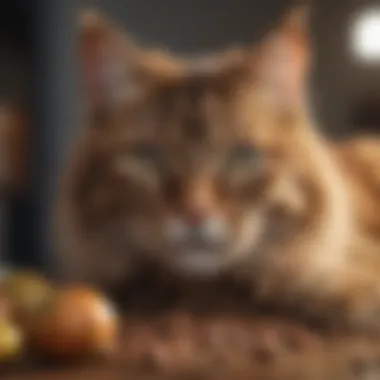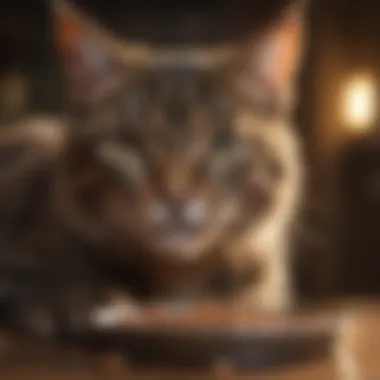Best Dry Cat Food for Managing Feline Diabetes


Intro
Managing a cat with diabetes presents unique challenges that require careful attention to diet and general well-being. This article aims to dissect the intricacies of choosing the most fitting dry cat food that can support your feline friend's health while living with diabetes. Diabetic cats have specific nutritional needs to manage their glucose levels effectively.
Many pet owners may not realize that dry cat food is not a one-size-fits-all solution. There are numerous factors at play, from ingredient composition to carbohydrate levels, and understanding these can make all the difference when it comes to your cat's energy, mood, and overall health.
As you wade through various brands and formulations, it's crucial to know what to look for. Not only will we explore key nutrients that should be included in your cat's diet, but we will also highlight ingredients to avoid, shedding light on their potential negative impacts on a diabetic cat. Through this investigation, we will highlight reputable brands that have been recognized for their quality and adherence to the dietary needs of diabetic cats.
The objective is simple: to equip pet owners with the knowledge they need to make informed decisions around dry cat food that helps their beloved feline maintain a healthy and balanced lifestyle.
Understanding Feline Diabetes
Comprehending feline diabetes is vital for anyone seeking to improve the health of their furry companions. The reality is, without a solid understanding of this condition, responsible pet ownership can unwittingly take a back seat. Understanding feline diabetes not only helps in managing this chronic disease but also equips pet owners with the knowledge to make informed decisions regarding their cat's nutrition, lifestyle, and overall well-being.
Diabetes in cats is a serious issue, often characterized by a malfunction in insulin regulation which can lead to elevated blood sugar levels. The crux of the matter is that fed correctly, cats can significantly enhance their quality of life and potentially prolong their years. The sheer complexity of feline diabetes necessitates a closer look to ensure our feline friends receive the best care possible.
What is Feline Diabetes?
Feline diabetes mellitus primarily exists in two forms: Type 1 and Type 2. Type 1 is uncommon in cats, as it typically involves the pancreas's inability to produce insulin. Type 2, on the other hand, is more prevalent and usually results from insulin resistance. Essentially, the cat’s body doesn’t respond appropriately to insulin, leading to higher sugar levels in the bloodstream. This condition can often be overlooked in its early stages but, left unchecked, it can lead to serious complications, including complications in other vital organs such as the kidneys or the liver.
To put it simply, feline diabetes is akin to a traffic jam in your cat's body. The insulin, which should regulate sugar levels, is not functioning smoothly, causing chaos with glucose management. Knowing this foundational concept is key to grasping the subsequent need for careful dietary choices.
Causes and Risk Factors
Identifying the causes and risk factors behind feline diabetes is essential, as it can aid in prevention and management. Some of the primary culprits include:
- Obesity: Overweight cats have a higher tendency to develop diabetes due to the increased fat which affects insulin function.
- Age: Middle-aged to older cats face a higher risk, particularly those around the age of seven and older.
- Diet: Feeding cats a high carbohydrate diet can contribute to this condition; after all, they are obligate carnivores.
- Sedentary Lifestyle: Cats that don't get enough exercise may find themselves at risk of diabetes, similar to humans undergoing lifestyle diseases.
A mix of these factors can lead to insulin resistance and the onset of diabetes. It’s a bit like ignoring your car's maintenance: neglect it long enough, and you're bound for trouble.
Symptoms to Watch For
Being vigilant about your cat's health is paramount. Feline diabetes can manifest through various symptoms, some of which may be easily mistaken for other ailments. It's crucial for pet owners to recognize the warning signs, as early intervention can make all the difference. Here are some symptoms to keep an eye out for:
- Increased Thirst: If your cat suddenly seems to guzzle water like a fish out of water, it could indicate high blood sugar levels.
- Frequent Urination: A noticeable uptick in litter box visits can be a telltale sign.
- Weight Loss: Despite a seemingly normal appetite, sudden weight loss is undeniably concerning.
- Lethargy: If your usually sprightly feline is less active, it’s time to take stock of their health.
- Poor Coat Condition: A once-shiny coat that suddenly becomes dull can sometimes point toward underlying health issues, such as diabetes.
While these symptoms may ring alarm bells, they are not exclusive to diabetes. A timely visit to the vet can provide essential diagnostics and treatment options.
"Knowledge is a potent weapon; wield it wisely to safeguard your cat’s health."
Paying attention to these symptoms fosters responsible pet ownership and ensures you're combating feline diabetes effectively.
The Importance of Diet in Diabetes Management
Diet plays a pivotal role in managing feline diabetes, serving as a cornerstone of an effective treatment strategy. For cats suffering from diabetes, the right dietary regimen can mean the difference between health and complications. Tailoring a diet specifically for diabetic cats helps keep their blood sugar in check, promotes weight management, and improves overall well-being. This section discusses the essential elements that influence diet choices and highlights how they directly impact a diabetic cat’s health.
Nutritional Requirements for Diabetic Cats


When considering a diet for diabetic cats, it's crucial to look at their unique nutritional needs.
- High Protein Content: Cats are obligate carnivores, which means they thrive on high protein diets. Protein supports muscle mass and provides a steady release of energy without spiking blood sugar levels.
- Moderate Fat Levels: While fats should not be entirely avoided, it's essential to ensure moderate levels are included. Healthy fats are vital for energy and can help with the absorption of various nutrients.
- Low Carbohydrate Ratio: Diabetic cats benefit significantly from a diet low in carbohydrates. This reduction helps manage blood glucose levels and decrease the risk of obesity, which overly stresses the pancreas.
Maintaining these nutritional standards can lead to a more stable condition in diabetic cats, promoting better health outcomes and a happier life.
Role of Carbohydrates and Proteins
The interplay between carbohydrates and proteins is vital when it comes to a cat’s diabetes management. Carbohydrates, which are usually included in many dry cat foods, can cause fluctuations in blood sugar levels. The recommendation for diabetic cats is to choose foods where the carbohydrate content is significantly reduced. Here’s why:
- Limited Carbs: A diet with lower carbohydrates leads to fewer spikes in blood sugar. Simple carbs, found in grains and fillers, should be avoided as they offer little nutritional value and can adversely affect glucose levels.
- Importance of Proteins: Protein acts like a buffer. It provides energy without leading to an insulin response, which is essential for maintaining blood sugar levels. Therefore, focusing on high-quality protein sources such as chicken, turkey, or fish should be a priority.
Impact of Fiber on Blood Sugar Levels
Fiber is often overlooked yet is a crucial component in the diets of diabetic cats. It plays several roles:
- Slows Digestion: Dietary fiber helps slow the digestion process, which aids in controlling blood sugar spikes after meals. This steady release of glucose into the bloodstream is crucial for maintaining stable energy levels.
- Promotes Satiety: Higher fiber content can make your cat feel fuller, helping to manage obesity—a common issue among diabetic cats. Managing weight can help prevent the condition from worsening.
- Supports Gut Health: Fiber also benefits the digestive system. A healthy gut can enhance the absorption of nutrients and promote overall health, which is particularly important for diabetic cats.
"A well-planned diet can significantly enhance the quality of life for a diabetic cat, transforming their daily experience into a healthier, happier one."
With this foundation, the subsequent sections will delve deeper into choosing suitable dry cat food and understanding vital ingredients to seek and avoid.
Choosing Dry Cat Food: Key Considerations
Selecting the right dry cat food is crucial for managing feline diabetes effectively. It’s not just about filling up your cat's bowl but ensuring that every morsel serves a purpose. A thoughtful approach to choosing food can make a big difference in your furry friend’s health and wellbeing. Understanding the specific needs of diabetic cats can guide you toward options that help stabilize their blood sugar levels, reduce risks of complications, and ultimately contribute to a happier and healthier life.
Essential Ingredients for Diabetic Cats
When hunting for dry cat food, you want to zero in on ingredients that foster diabetes management. The cornerstone of any diabetic diet is high-quality protein. Proteins help maintain muscle mass while controlling weight—a vital factor for diabetic cats. Look for options where meats like chicken or turkey top the ingredient list.
Healthy fats also deserve attention. Ingredients like fish oil or chicken fat not only provide essential fatty acids but can also help in nutrient absorption. Then there are low glycemic index carbohydrates. Think whole grains like brown rice or oatmeal; they break down slower in the body, preventing sudden spikes in blood sugar.
Furthermore, consider fiber sources such as beet pulp or psyllium husk. Fiber can slow down glucose absorption, which is particularly beneficial for cats with diabetes. Ensuring these elements are present in your cat's food can create a solid foundation for balanced nutrition.
Ingredients to Avoid
Conversely, navigating your way through the aisles also requires a keen eye to dodge certain ingredients. Avoid dry cat foods laden with high levels of carbs, especially those featuring corn or wheat. These ingredients can result in rapid increases in blood sugar, wreaking havoc on a diabetic cat's system.
Additionally, artificial additives and fillers should be placed on your no-go list. Ingredients like propylene glycol, artificial preservatives, and colorants serve no nutritional purpose and can even harm your cat’s health. Keep an eye out for products that contain excessive sugars or sweeteners, as they can undermine the entire purpose of feeding a diabetic-friendly diet.
Reading Labels: What to Look For
Effective label reading can be an art, but mastering it is essential. Start by checking the first five ingredients; these form the bulk of the recipe. Ensure that quality protein takes the lead.
Next, look for the Guaranteed Analysis, which offers a breakdown of the food’s protein, fat, fiber, and moisture content. Aim for at least 30% protein and moderate levels of fats, ideally around 15-20%.
Consider also the presence of Nutritional Adequacy Statements which are often found on the packaging. They indicate if the food meets the AAFCO (Association of American Feed Control Officials) guidelines for complete and balanced nutrition. Furthermore, scrutinizing feeding recommendations can provide insight into appropriate portion sizes based on your cat's weight.
"A discerning eye on labels can shed light on the nutritional value of the food and avert costly mistakes in managing your cat's diabetic needs."


When piecing together your cat’s dietary puzzle, keep these essential ingredients and simple guidelines in mind for making informed choices. A bit of research today can pave the way for a healthier life for your feline companion.
Recommended Brands of Dry Cat Food
When it comes to managing feline diabetes, selecting the right dry cat food is central to achieving optimal health for your pet. The market is awash with choices, but not all brands offer the same quality or efficacy. It’s crucial to sift through the clutter and pinpoint brands that focus on the specific dietary needs of diabetic cats. Here, I'll explore what makes certain brands stand out and why these choices are pivotal in the dietary management of diabetes.
A good dry food for diabetic cats should prioritize low carbohydrate content and high-quality protein. The right brand not only supports stable blood sugar levels but also enhances overall well-being. This section will delve into a comparative analysis of different brands, focusing on elements such as ingredient quality, nutrient efficacy, and feedback from cat owners that inform us about real-world performance.
Brand Comparisons: Quality and Efficacy
In the realm of diatry food for diabetic felines, not all brands are created equal. Evaluating their quality and efficacy involves looking at several factors. One key area to consider is the source of protein. Brands that utilize real meat as the primary ingredient versus those that rely on meat by-products or fillers generally provide better nutrition. For instance, brands like Royal Canin and Hill's Prescription Diet have garnered a positive reputation for their veterinary formulations aimed at managing diabetes in cats.
Key Factors to Compare:
- Protein Quality: A higher quality protein helps in maintaining muscle mass, which can be crucial for diabetic cats.
- Carbohydrate Levels: It's best if the formula keeps carbohydrates low, ideally below 10% of the total caloric intake.
- Fiber Content: Added fiber can assist in moderating blood sugar spikes.
- Owner Feedback: Reading the reviews and experiences shared by other cat owners can provide genuine insights.
By checking aspects like these and utilizing comparisons available on platforms like Reddit, cat owners can make more informed decisions. Furthermore, many brands regularly release nutritional studies and product reviews that can be helpful in understanding their impact on feline diabetes management.
Top Brands for Diabetic Cats
Several brands have earned their keep as top contenders for dry food suitable for diabetic cats. Let’s look at a few that are consistently recommended by veterinarians and pet owners alike.
- Royal Canin Feline Glycobalance
This brand provides a specialized formula with high protein and low carbohydrates, specifically formulated for diabetic cats. It’s rich in dietary fiber which aids in regulating glucose levels. - Hill's Prescription Diet m/d
Focusing on glucose control, Hill's produces a diet that's been well-researched. It's especially designed to support metabolic health in diabetic cats, boasting a high protein content and low carbohydrate levels. - Blue Buffalo Wilderness
Known for its focus on natural ingredients, Blue Buffalo's wilderness formula is grain-free and offers a protein-packed diet that fits the needs of diabetic cats well while ensuring they enjoy their meals. - Purina Pro Plan Veterinary Diets
This is another strong option that focuses on managing diabetes with its specially formulated diets. It's well-regarded for quality and accessibility and often recommended by vets for cat owners who are managing diabetes.
Choosing the right dry food is crucial for eyes on the long-term health of your feline friend. The right brand not only keeps their taste buds excited but also helps to regulate their health as they navigate the challenges of diabetes management. By paying attention to the ingredients, quality, and proven efficacy, you are setting your pet on a path to better health.
Homemade Dry Cat Food: Feasibility and Considerations
When managing feline diabetes, the question of homemade dry cat food can arise. The idea might seem appealing for pet owners who wish to take control of their cat's diet. However, this approach comes with its unique set of advantages and obstacles that one must navigate. It can be that breath of fresh air for some, yet potentially daunting for others. Ensuring a balanced meal suitable for a diabetic cat is crucial, as improper formulations can lead to serious health implications. This section will explore the feasibility of whipping up homemade dry cat food, examining both the potential benefits and considerations involved in this endeavor.
Planning a Homemade Diet
Creating a homemade diet for your diabetic cat requires more than just mixing a bunch of food together and hoping for the best. It's similar to walking a tightrope — one misstep could lead to an unhealthy situation. First, consider what you're aiming to achieve with the diet. For instance, you might want to reduce your feline's blood sugar levels and improve overall health. A balanced diet is essential for diabetic cats to maintain steady blood sugar levels.
Start by consulting with a veterinarian or a pet nutritionist experienced in feline diabetes. They can provide guidance on how to design a suitable meal plan based on your cat's specific health needs. Here’s a simple guideline to keep in mind:
- Research your cat's specific requirements.
- Note down the ingredients that work well and those that don't.
- Gradually introduce new foods to observe your cat’s reaction.
Necessary Nutritional Components
To make sure your homemade dry cat food meets your pet's dietary needs, you need to ensure it includes the essential nutritional components. What does that mean? A variety of nutrients must be included so your cat can thrive. Here are the key components to include:
- Proteins: Essential for muscle maintenance and energy. Options like chicken or fish are good. Look for lean cuts that are lower in fat content.
- Fats: While fat is often thought of negatively, small amounts are necessary for energy. Select healthy fats, such as fish oil, which can also support skin health.
- Carbohydrates: These should form a small part of the diet. Whole grains or vegetables can provide necessary carbs but monitor the type and quantity.
- Vitamins and Minerals: Ensure the diet is supplemented with essential vitamins and minerals to avoid deficiencies. Common additions include taurine, which is crucial for cats.
"To truly nurture your diabetic cat, balance is key. Jumping into any extremes can create chaos instead of harmony in their health."
Risks and Challenges of Homemade Diets


Creating homemade dry cat food isn't all sunshine and rainbows. It’s essential to understand the potential risks and challenges surrounding this endeavor. The complexity of formulating a proper diet can lead to serious health risks. Here are a few things to bear in mind:
- Nutritional Imbalance: It’s easy to overlook specific dietary needs when preparing food at home. If critical nutrients are missing, it can lead to deficiencies, resulting in health issues.
- Time-Consuming: Preparing homemade meals is no small feat. It can take significant time and effort to research, plan, and cook meals that are balanced.
- Monitoring Health: Regular health checks become even more critical. Any slight change in your cat's health could require adjustments to their diet.
Monitoring Your Cat's Health
Keeping an eye on your cat’s health might sound like a mundane task, but in the realm of feline diabetes management, it’s a cornerstone of effective care. Monitoring goes beyond just the scale; it’s about understanding the nuanced shifts in behavior, energy levels, and dietary responses. With diabetes, the stakes are higher since fluctuations in blood sugar can lead to serious health complications. Therefore, forming a habit of regular monitoring allows pet owners to catch potential issues before they escalate.
Regular Veterinary Health Checks
Regular vet check-ups are not just a box to tick off on a to-do list; they are vital for managing a diabetic cat's ongoing health. During these visits, veterinarians can perform blood tests to gauge glucose levels, assess weight fluctuations, and monitor overall well-being. These metrics are especially crucial for diabetic felines, as their conditions can change from one day to the next.
- Importance of Routine Exams: A check-up allows for adjustments to the treatment plan. Pets with diabetes often require changes in their insulin doses based on their weight or blood sugar readings. Regular visits help ensure that your cat isn’t cruising down the slippery slope of complicating factors.
- Recommendations for Frequency: Most vets suggest biannual or even quarterly check-ups for diabetic cats. This schedule helps maintain close tabs on any necessary adjustments in diet or medication. If complications arise, your vet can intervene sooner rather than later.
Adjusting Diet Based on Health Changes
Changing a cat’s diet might seem straightforward, but it’s a delicate operation that requires a keen attention to details. When managing feline diabetes, any changes in your cat's health can signal a need to adjust their diet. For instance, if your cat loses or gains an unexpected amount of weight, it could indicate that their insulin requirements have shifted.
- Indicators for Dietary Change: Here are signs that it might be time to revisit your cat's food:
- Unexplained weight gain or loss
- Increased thirst or urination
- Changes in energy levels, like lethargy or hyperactivity
It’s crucial to consult with a veterinarian before making any dietary adjustments. They can guide you on the nutritional requirements that correspond with your cat’s current health status.
- Benefits of Prompt Dietary Changes: Swift action can prevent further complications. For example, if a cat’s blood sugar levels spike, switching to a specialized diabetic dry food can help return them to a healthier range. Likewise, if insulin sensitivity changes, tweaking their carbohydrate intake can support better regulation of blood glucose levels.
"Regular monitoring and swift adjustments in diet can help ensure your diabetic cat isn’t just surviving, but thriving."
In closing, being proactive in monitoring your cat's health, including regular veterinary check-ups and adjusting dietary needs along the way, creates a solid foundation for an improved quality of life for your feline friend. You hold the reins in managing their diabetes, and every small effort adds up to a significant impact on their health.
End
The proper management of feline diabetes necessitates thoughtful dietary choices, which can fundamentally shape your cat’s well-being. Throughout this article, we’ve examined the critical aspects of selecting dry cat food that aids in managing this condition. From understanding the nutritional needs specific to diabetic cats to recognizing harmful ingredients that could exacerbate health issues, the information presented serves as a sturdy foundation for pet owners seeking to optimize their furry friends' diets.
Key elements of this conclusion include:
- Highlighting the importance of regular veterinary consultations, ensuring that dietary adjustments align with medical advice.
- Emphasizing that each feline has unique dietary needs, thus fostering a tailored approach to nutrition management.
- Recognizing the roles of proteins, carbohydrates, and fibers in crafting a balanced diet conducive to blood sugar regulation.
To put it succinctly, making well-informed dietary choices stands as a cornerstone in ensuring your cat leads a happy and healthy life despite the challenges posed by diabetes. Small changes can lead to significant impacts—in both health and quality of life.
Summary of Key Points
In reviewing the journey through feline diabetes management, several pivotal points deserve reiteration:
- Understanding Feline Diabetes: Acknowledge the nuances of this condition to better grasp its effects on your pet.
- Diet's Role: Recognize the direct influence of diet on managing blood sugar levels effectively.
- Selecting Food Wisely: Seek out brands that emphasize low carbohydrates, high protein, and appropriate fiber.
- Routine Monitoring: Regular check-ups with a vet can reveal necessary adjustments in diet.
- Stay Educated: Ongoing research and guidelines are vital; remaining informed benefits your pet profoundly.
Final Recommendations for Pet Owners
As you wade deeper into the complexities of managing feline diabetes, consider these final recommendations:
- Consult Your Veterinarian: Before making any diet changes, engage in open discussions with your vet to tailor a plan based on your cat’s specific needs.
- Experiment Gradually: Changes in diet should be implemented slowly, allowing for physiological adaptation and observation of tolerance.
- Monitor Weight and Well-Being: Regularly track your cat's weight and overall health to catch any possible complications early.
- Stay Adaptive: Be prepared to modify your cat's diet as their health status evolves; what works today may need adjustment tomorrow.
Ultimately, informed choices pave the way for a healthier, happier feline companion. take the plunge, do the research, and always choose with love.
Through a mindful approach to nutrition, you can significantly improve the quality of your cat’s life while effectively managing diabetes. Engage with your cat’s health journey and make each meal count.















